
Damascus is the capital of the Syrian Arab Republic; it is also the country's largest city, following the decline in population of Aleppo due to the battle for the city. It is colloquially known in Syria as aš-Šām (الشام) and titled the "City of Jasmine". In addition to being one of the oldest continuously inhabited cities in the world, Damascus is a major cultural center of the Levant and the Arab world. The city has an estimated population of 1,711,000 as of 2009.
The Western text-type is one of several text-types used in textual criticism to describe and group the textual character of Greek New Testament manuscripts. It is the predominant form of the New Testament text witnessed in the Old Latin and Peshitta translations from the Greek, and also in quotations from certain 2nd and 3rd-century Christian writers, including Cyprian, Tertullian and Irenaeus. The Western text had a large number of characteristic features, which appeared in text of the Gospels, Book of Acts, and in Pauline epistles. The Catholic epistles and the Book of Revelation probably did not have a Western form of text. It was named "Western" by Semmler (1725–1791), having originated in early centers of Christianity in the Western Roman Empire.
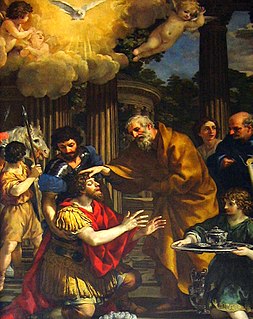
Ananias was a disciple of Jesus at Damascus mentioned in the Acts of the Apostles in the Bible, which describes how he was sent by Jesus to restore the sight of "Saul, of Tarsus" and provide him with additional instruction in the way of the Lord.
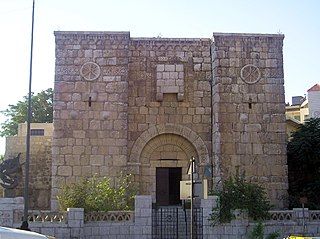
Bab Kisan is one of the seven ancient city-gates of Damascus, Syria. The gate, which is now located in the southeastern part of the Old City, was named in memory of a slave who became famous during a conquest by the Caliph Mu'awiya. The wall was built during the Roman era and was dedicated to Saturn. Bab Kisan was the escape route of St Paul.

Abila Lysaniou or Abila Lysaniae or Abila was an ancient city, on the Abana River and capital of ancient Abilene, Coele-Syria. The site is currently that of the village of Souq Wadi Barada, circa 20 km (12 mi) northwest of Damascus, Syria. It has also been identified as the village of Abil just south of Homs in central Syria. The city's surname is derived from Lysanias, a governor of the region.
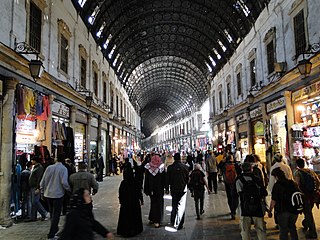
Al-Hamidiyah Souq is the largest and the central souk in Syria, located inside the old walled city of Damascus next to the Citadel. The souq is about 600 metres (2,000 ft) long and 15 metres (49 ft) wide, and is covered by a 10-metre (33 ft) tall metal arch. The souq starts at Al-Thawra street and ends at the Umayyad Mosque plaza, and the ancient Roman Temple of Jupiter stands 40 feet tall in its entrance.
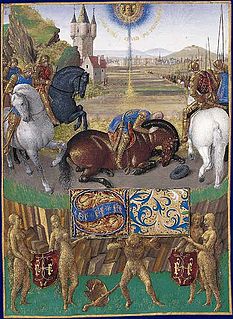
The conversion of Paul the Apostle, was, according to the New Testament, an event in the life of Paul the Apostle that led him to cease persecuting early Christians and to become a follower of Jesus. It is normally dated to AD 33–36. Since his birth is estimated at 5 AD, he would have been somewhere around the age of 28-31 at his conversion. The phrases Pauline conversion, Damascene conversion and Damascus Christophany, and road to Damascus allude to this event.

Bab Tuma is a borough of the Old City of Damascus in Syria, one of the seven gates inside the historical walls of the city, and a geographic landmark of Early Christianity. It owes its name to Saint Thomas the Apostle, one of the twelve apostles of Jesus Christ. During the Roman era, the gate was dedicated to Venus.

Bab al-Faraj also known as Bab al-Bawabijiyah and Bab al-Manakhiliyah is one of the gates of the old city of Damascus in Syria. The gate was built as part of a large program to re-fortify the city following its capture by Nur ad-Din Zangi in 1154. The twin gate crosses a bridge over a section of the Barada river that runs along the northern city walls of Damascus. The gate is notable for being the only surviving gate in the city that was built completely after the Muslim conquest of Damascus.

Bab al-Faradis or Bab al-Amara is one of the seven ancient city-gates of Damascus, Syria. One of the city's northern gates, it was named "the paradise gate" in the Roman age because it was surrounded by numerous water sources and gardens. The other name, Bab Al-Amara, refers to a name of a famous district in the old city where people in the 14th century would meet. During the Roman era, the gate was dedicated to Mercury.

Bab al-Jabiya is one of the seven ancient city-gates of Damascus, Syria. During the Roman era, the gate was dedicated to Mars. Bab al-Jabiya was the main entrance on the city's west side. The gate opens on Medhat Pasha Souq, which is the modern western half of the Street Called Straight, the Roman east-west artery (decumanus), which still connects it to Bab Sharqi. The gate's modern name dates to the Umayyad period and comes from the name of Jabiyah in the Golan Heights, then the capital city of the Ghassanids, allies of the Roman Empire.

Bab al-Salam is one of the seven ancient city-gates of Damascus, Syria. During the Roman era, it was also known as "Gate of the Moon".
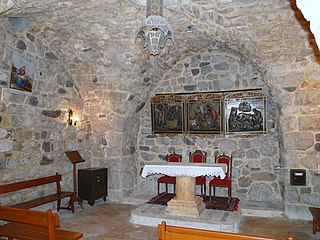
The House of Saint Ananias is an ancient underground structure in Damascus, Syria, that is alleged to be the remains of the home of Ananias of Damascus, where Ananias baptized Saul. Archaeological excavations in 1921 found the remains of a Byzantine church from the 5th or 6th century AD, adding physical evidence to support local tradition that the chapel has an early-Christian origin. The building is at the end of the Street Called Straight near the Bab Sharqi. As of 2010, the structure was still in use as a church.
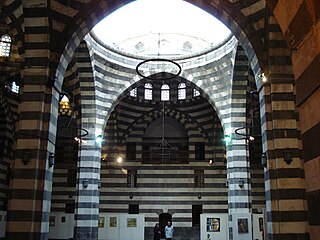
Khan As'ad Pasha is the largest khan in the Old City of Damascus, covering an area of 2,500 square metres (27,000 sq ft). Situated along Al-Buzuriyah Souq, it was built and named after As'ad Pasha al-Azm, the governor of Damascus, in 1751-52. Khan As'ad Pasha has been described as one of the finest khans of Damascus, and the most "ambitious" work of architecture in the city. Throughout the Ottoman era, it hosted caravans coming from Baghdad, Mosul, Aleppo, Beirut and elsewhere in the Middle East.

The Ancient City of Damascus is the historic city centre of Damascus, Syria. The old city which is one of the oldest continuously inhabited cities in the world, contains numerous archaeological sites, including some historical churches and mosques. Many cultures have left their mark, especially Hellenistic, Roman, Byzantine and Islamic. In 1979, the historical center of the city, surrounded by walls of Roman era, was declared a World Heritage Site by UNESCO. In June 2013, UNESCO included all Syrian sites on the list of World Heritage in Danger to warn of the risks to which they are exposed because of the Syrian Civil War.
Al-Hariqa is a neighborhood in Damascus, Syria. It lies inside the walls of the old city south of the Citadel of Damascus between the late-Ottoman-era markets of al-Hamidiyah Souq and Medhat Pasha Souq. The neighborhood was known as Sidi Amoud after a famous holy man who was buried there. It was called al-Hariqa (Conflagration) after the area was completely burned down in 1925 under French bombing in response to the Great Syrian Revolt. It is a commercial hub famous for its clothing markets. The famous Nur al-Din Bimaristan is located in the area.

Al-Shaghour is a municipality and a neighborhood located in the old walled city of Damascus, Syria, south and east of the Old City, and east of al-Midan. Al-Shaghour is one of the oldest recorded neighborhoods in the city. The traditional neighborhood is divided into the part located within the Old City walls, known as Shaghour al-Juwani, and the much larger part located outside the walls. The latter part has become a municipality known as "al-Shaghour" and includes the districts (hayy) of Shaghour al-Barrani, Bab Sharqi, al-Zuhur, al-Wihdah, al-Bilal, al-Nidal, Ibn al-Asakir and Rawdat al-Midan.

The Ancient City of Aleppo is the historic city centre of Aleppo, Syria. Before the Syrian Civil War, many districts of the ancient city remained essentially unchanged since its construction during the 12th to the 16th century. Being subjected to constant invasions and political instability, the inhabitants of the city were forced to build cell-like quarters and districts that were socially and economically independent. Each district was characterized by the religious and ethnic characteristics of its inhabitants.
























